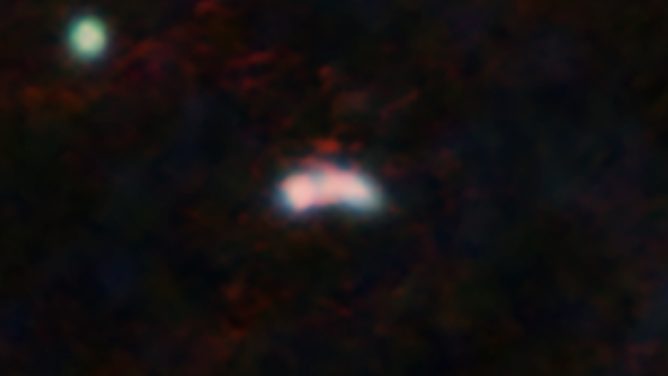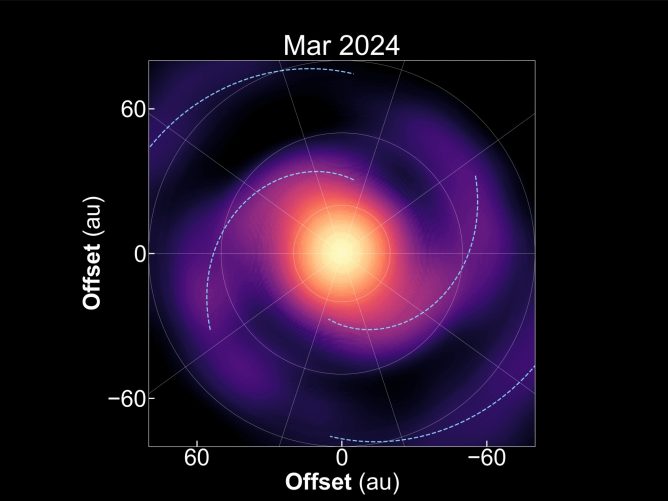Phosphorus, present in our DNA and cell membranes, is an essential element for life as we know it. But how it arrived on the early Earth is something of a mystery. Astronomers have now traced the journey of phosphorus from star-forming regions to comets using the combined powers of ALMA and the European Space Agency’s probe Rosetta. Their research shows, for the first time, where molecules containing phosphorus form, how this element is carried in comets, and how a particular molecule may have played a crucial role in starting life on our planet.
“Life appeared on Earth about 4 billion years ago, but we still do not know the processes that made it possible,” says Víctor Rivilla, the lead author of a new study published today in the journal Monthly Notices of the Royal Astronomical Society. The new results from the Atacama Large Millimeter/Submillimeter Array (ALMA) and from the ROSINA instrument on board Rosetta, show that phosphorus monoxide is a key piece in the origin-of-life puzzle.

This ALMA image shows a detailed view of the star-forming region AFGL 5142. A bright, massive star in its infancy is visible at the center of the image. The flows of gas from this star have opened up a cavity in the region, and it is in the walls of this cavity (shown in colour), that phosphorus-bearing molecules like phosphorus monoxide are formed. The different colors represent material moving at different speeds.
Credit: ALMA (ESO/NAOJ/NRAO), Rivilla et al.
The ALMA observations showed that phosphorus-bearing molecules are created as massive stars are formed. Flows of gas from young massive stars open up cavities in interstellar clouds. Molecules containing phosphorus form on the cavity walls, through the combined action of shocks and radiation from the infant star. The astronomers have also shown that phosphorus monoxide is the most abundant phosphorus-bearing molecule in the cavity walls.
After searching for this molecule in star-forming regions with ALMA, the team moved on to a Solar System object: the now-famous comet 67P/Churyumov–Gerasimenko. The idea was to follow the trail of these phosphorus-bearing compounds. If the cavity walls collapse to form a star, particularly a less-massive one like the Sun, phosphorus monoxide can freeze out and get trapped in the icy dust grains that remain around the new star. Even before the star is fully formed, those dust grains come together to form pebbles, rocks and ultimately comets, which become transporters of phosphorus monoxide.
ROSINA, which stands for Rosetta Orbiter Spectrometer for Ion and Neutral Analysis, collected data from 67P for two years as Rosetta orbited the comet. Astronomers had found hints of phosphorus in the ROSINA data before, but they did not know what molecule had carried it there. Kathrin Altwegg, the Principal Investigator for Rosina and an author in the new study, got a clue about what this molecule could be after being approached at a conference by an astronomer studying star-forming regions with ALMA: “She said that phosphorus monoxide would be a very likely candidate, so I went back to our data and there it was!”
This first sighting of phosphorus monoxide on a comet helps astronomers draw a connection between star-forming regions, where the molecule is created, all the way to Earth.
“The combination of the ALMA and ROSINA data has revealed a sort of chemical thread during the whole process of star formation, in which phosphorus monoxide plays the dominant role,” says Rivilla, who is a researcher at the Arcetri Astrophysical Observatory of INAF, Italy’s National Institute for Astrophysics.
“Phosphorus is essential for life as we know it,” adds Altwegg. “As comets most probably delivered large amounts of organic compounds to the Earth, the phosphorus monoxide found in comet 67P may strengthen the link between comets and life on Earth.”
This intriguing journey could be documented because of the collaborative efforts between astronomers. “The detection of phosphorus monoxide was clearly thanks to an interdisciplinary exchange between telescopes on Earth and instruments in space,” says Altwegg.
This article is based on the press release “Astronomers Reveal Interstellar Thread of One of Life’s Building Blocks” issued by the European Southern Observatory.
Paper and the Research Team
This research was presented in V. M. Rivilla et al. “ALMA and ROSINA detections of phosphorus-bearing molecules: the interstellar thread between star-forming regions and comets” in the Monthly Notices of the Royal Astronomical Society in January 2020.
The team is composed of V. M. Rivilla (INAF-Osservatorio Astrofisico di Arcetri, Florence, Italy [INAF-OAA]), M. N. Drozdovskaya (Center for Space and Habitability, University of Bern, Switzerland [CSH]), K. Altwegg (Physikalisches Institut, University of Bern, Switzerland), P. Caselli (Max Planck Institute for Extraterrestrial Physics, Garching, Germany), M. T. Beltrán (INAF-OAA), F. Fontani (INAF-OAA), F.F.S. van der Tak (SRON Netherlands Institute for Space Research, and Kapteyn Astronomical Institute, University of Groningen, The Netherlands), R. Cesaroni (INAF-OAA), A. Vasyunin (Ural Federal University, Ekaterinburg, Russia, and Ventspils University of Applied Sciences, Latvia), M. Rubin (CSH), F. Lique (LOMC-UMR, CNRS–Université du Havre), S. Marinakis (University of East London, and Queen Mary University of London, UK), L. Testi (INAF-OAA, ESO Garching, and Excellence Cluster “Universe”, Germany), and the ROSINA team (H. Balsiger, J. J. Berthelier, J. De Keyser, B. Fiethe, S. A. Fuselier, S. Gasc, T. I. Gombosi, T. Sémon, C. -y. Tzou).









